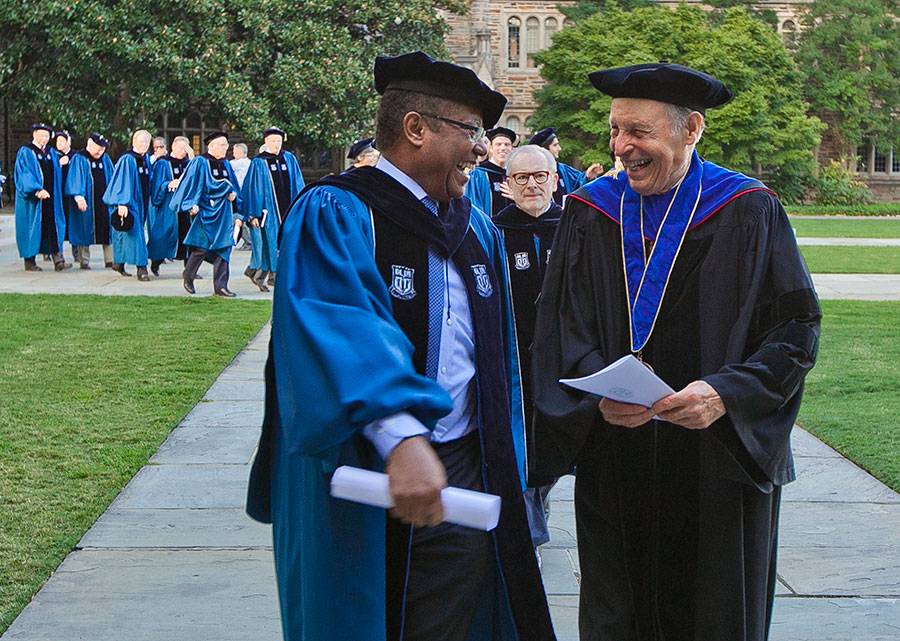Duke Flags Lowered: Physics Professor J. Horst Meyer Dies

Johannes Horst Meyer, a highly regarded physicist who taught at Duke for more than 50 years, died from cancer on Sunday. He was 90.
Meyer’s positive presence could be felt in all corners of the university, from the Sarah P. Duke Gardens to the laboratories in the physics department. For his numerous contributions to campus research, teaching and culture, he was awarded in 2014 the Duke University Medal, the school’s highest honor for distinguished service.
“A common thread through all was Horst's incredible enthusiasm and joie de vivre,” said Robert P. Behringer, James B. Duke Professor of Physics at Duke and Meyer’s former Ph.D. student. “With his passing, Duke has lost a very special friend and supporter.”
Meyer, grandson of pioneering pharmacologist and anesthesiologist Hans Horst Meyer, was born in Berlin. He completed a doctoral degree in physics at the University of Geneva in 1953 and served as a postdoctoral associate in the Clarendon Laboratory at the University of Oxford before starting as an assistant professor at Duke in 1959.
During his 57 years at Duke, Meyer established himself as one of the world's leading authorities on experimental condensed matter physics, particularly the properties of fluids near their liquid-vapor critical point.
Meyer was named the Fritz London Professor of Physics at Duke in 1984 and became an emeritus member of the faculty in 2004. Meyer was also considered the unofficial historian of the Duke physics department, writing on a variety of topics, including the career of Hertha Sponer, the first woman on the Duke physics faculty.
His scientific work earned him a number of accolades, including the Jesse W. Beams Award (1982) and the Fritz London Memorial Prize (1993). He also served as co-editor and later honorary editor of the Journal of Low Temperature Physics.
Meyer was particularly proud of his role as a mentor and teacher to young physicists beginning their careers at Duke. His former students include a Nobel Prize winner, two members of the National Academy of Sciences and 12 fellows of the American Physical Society.
“His students will remember his boisterous greeting of 'HAT', how are things? And of course, the doughnuts that he used to entice people into the lab on Saturdays,” Behringer said.
Robert C. Richardson, one of Meyer’s first doctoral students who later went on to share the 1996 Nobel Prize, described Meyer as a “conscientious mentor” and “valued friend.”
Meyer’s dedication to the Duke community extended beyond the classroom and the laboratory. An ardent lover of classical music and nature, he served on the advisory board of the Duke Chamber Arts Society for more than 30 years, and could often be spotted hanging and maintaining dozens of bluebird boxes around the gardens.
Meyer’s deep love for Duke Gardens began shortly after his arrival at Duke and only grew with time. He contributed to planning several developments in the Asiatic Arboretum, of which he was particularly fond, and also worked on renovation projects. He became a founding member of the Sarah P. Duke Gardens Board of Advisors in 1991 and was instrumental in the development of the Doris Duke Center in the late 1990s.
“Dr. Meyer played a leading role in creating the Gardens as we see them today,” said Bill LeFevre, the Garden’s executive director. “His love of Duke University and of the Gardens, which he described as ‘a little piece of heaven,’ knew no bounds.”
In 2004, Meyer presented the university with a portrait and medical memorabilia belonging to his grandfather, Hans Horst Meyer. These materials are now part of the History of Medicine Collections at Duke.
Meyer and his wife, Ruth Mary Hunter, were married 60 years until her death in 2013. They had two sons: Richard, who died in 1994, and Christopher, who is currently a staff physicist at the National Institute of Standards and Technology (NIST) in Gaithersburg, Maryland.
In lieu of flowers, memorial donations may be made to the Sarah P. Duke Gardens.